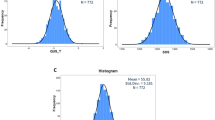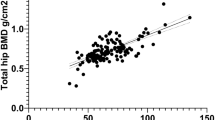Abstract:
The aim of the study was to evaluate whether computed digital absorptiometry (CDA) of the hand might be a useful screening technique for identifying patients with postmenopausal osteoporosis and to compare the results of CDA with those of dual-energy X-ray absorptiometry (DXA) of the lumbar spine and femoral neck. We studied 230 postmenopausal women (mean age 58.4 ± 7.9 years). For CDA, bone mineral density (BMD) was measured with an AccuDEXA Schick densitometer in the third middle phalanx of the nondominant hand. For DXA, BMD of the lumbar spine and upper femur was assessed using a DXA Hologic QDR-1000 densitometer. We did a comparative analysis (ANOVA) and linear correlation tests. Sensitivity and specificity of CDA and receiver operating characteristic (ROC) curves for the diagnosis of osteoporosis were calculated. The mean BMD with CDA was 0.445 ± 0.084 (T-score: −1.27 ± 1.29). The mean BMD (g/cm2) with DXA at the lumbar spine was 0.877 ± 0.166 (T-score: −1.52 ± 1.59) and 0.708 ± 0.127 at the femoral neck (T-score: −1.12 ± 1.25). BMD at the lumbar spine and femoral neck correlated positively with CDA of the hand (r= 0.66 and r= 0.65 respectively, p<0.001). When using as cut-off a T-score of −2.5, according to WHO criteria, 76 women (33%) had osteoporosis of the lumbar spine and/or femoral neck with DXA and 42 (18%) with CDA (p<0.001). The kappa score for osteoporosis was 0.33 for CDA versus spinal DXA and 0.35 for CDA versus femoral DXA. With the cut-off level used, sensitivity and specificity of CDA in detecting osteoporosis at the lumbar spine were 0.39 and 0.90, respectively; sensitivity and specificity of CDA in identifying osteoporosis at the femoral neck were 0.58 and 0.87, respectively. The positive predictive value of CDA for osteoporosis was 69% and the negative predictive value was 75%. The area under the ROC curve for osteoporosis was 0.822 ± 0.028. We conclude that: (a) CDA assessment has a moderate correlation with BMD measured by DXA at the lumbar spine and femoral neck; (b) CDA has a low sensitivity for the diagnosis of osteoporosis compared with spinal and femoral DXA; and (c) predictive values for osteoporosis at both the lumbar spine and femoral neck are acceptable.
Similar content being viewed by others
Author information
Authors and Affiliations
Additional information
Received: September 2000 / Accepted: January 2001
Rights and permissions
About this article
Cite this article
Fiter, J., Nolla, J., Gómez-Vaquero, C. et al. A Comparative Study of Computed Digital Absorptiometry and Conventional Dual-Energy X-ray Absorptiometry in Postmenopausal Women . Osteoporos Int 12, 565–569 (2001). https://doi.org/10.1007/s001980170078
Issue Date:
DOI: https://doi.org/10.1007/s001980170078




